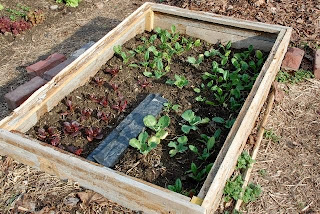 We have reached two boundaries. One is the end of outdoor produce and beginning to grow a little of something indoors. The other is beginning to draw down what is in storage.
We have reached two boundaries. One is the end of outdoor produce and beginning to grow a little of something indoors. The other is beginning to draw down what is in storage.One example of using what is in storage is the potato-pepper-onion meal. The potatoes and peppers are from the garden. I stored the potatoes in the cellar, but noticed that they are beginning to sprout. That means that they will begin turning soft fairly soon. The peppers were blanched and frozen when we had more than we could eat. The onions would have been scallions from the garden, but with some 40 inches of snow they weren't available.
 As for trying to grow something, one experiment this year is to grow some lettuce under lights in the cellar. I currently have four trays under two fluorescent fixtures. I harvested a grand total of slightly less than three ounces of little leaves last week. I expected the lettuces would grow larger (and perhaps they will) but since they have a fairly deep root and are in little pots I now think this experiment fail to produce enough to justify the time and electricity (about one kWh per day). I did later add some potting soil to the bottom of the tray so that the roots that have grown out of the bottom of the pots have a place to expand. But I think the real answer would be to plant the lettuce in much deeper containers and that means more potting soil and fewer plants in the same space.
As for trying to grow something, one experiment this year is to grow some lettuce under lights in the cellar. I currently have four trays under two fluorescent fixtures. I harvested a grand total of slightly less than three ounces of little leaves last week. I expected the lettuces would grow larger (and perhaps they will) but since they have a fairly deep root and are in little pots I now think this experiment fail to produce enough to justify the time and electricity (about one kWh per day). I did later add some potting soil to the bottom of the tray so that the roots that have grown out of the bottom of the pots have a place to expand. But I think the real answer would be to plant the lettuce in much deeper containers and that means more potting soil and fewer plants in the same space.The other source of produce from the garden in the winter is what is in the cold frames outside (kale, mache, claytonia and lettuce). I haven't seen what is happening out there for over two weeks because of the snow. But that provides an opportunity to see what happens when the cold frames remain covered with snow for a long time.

























